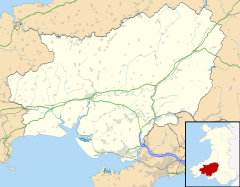Kidwelly
Kidwelly
| |
|---|---|
 | |
Location within Carmarthenshire | |
| Population | 3,523 (ward 2011)[1] |
| OS grid reference | SN407067 |
| Community |
|
| Principal area | |
| Preserved county | |
| Country | Wales |
| Sovereign state | United Kingdom |
| Post town | KIDWELLY |
| Postcode district | SA17 |
| Dialling code | 01554 |
| Police | Dyfed-Powys |
| Fire | Mid and West Wales |
| Ambulance | Welsh |
Llanelli | |
| Website | kidwelly.gov.uk |
Kidwelly (Welsh: Cydweli) is a town and community in Carmarthenshire, southwest Wales, approximately 7 miles (11 km) northwest of the most populous town in the county, Llanelli. In the 2001 census the community of Kidwelly returned a population of 3,289,[2] increasing to 3,523 at the 2011 Census.
It lies on the
History




This section possibly contains original research. (October 2023) |
The earliest written form of the name, 'Cetgueli', is recorded by the monk,
The substantial and well preserved
A field in the neighbouring forest of Kingswood, Maes Gwenllian is known as the location of a battle in 1136, in which Princess Gwenllian, sister of Owain Gwynedd, led her husband's troops into battle against a Norman army during his absence. She is believed to have been killed either during the battle or shortly afterwards, historians debate whether her death was at Maes Gwenllian or if she was marched back to Kidwelly Castle to be beheaded there.
Although being an ancient town, Kidwelly grew significantly during the
The population of Kidwelly in 1841 was 1,563.[3]
An atmospheric quotation from a despondent vicar in the nineteenth century provides insight to times gone by;
Kidwelly Parish Church records, 1851: "Remarks: [MS torn] . . . Lords day in this Town is but very little regarded as a day for spiritual worship [pub] lick houses are allowed to be open, and frequented during Divine Service. Publick [hou]ses are very numerous in this place, and even the Town Clerk keeps a . . . publick house. Often times on the Lord's day we are not only hear cursing and . . . once swearing in our streets, but frequently we see most brutal fighting, and . . . [n]otice taken thereof by the authority of the Town. This is the cause why places [of wor]ship are so little frequented and religion so little appreciated and professed at Kidwelly." Thomas Griffiths, Vicar [1]
Kidwelly Town Hall, which is currently disused, was completed in 1878.[4]
In 1919 Mabel Greenwood, who lived at Kidwelly with her husband, the solicitor Harold Greenwood, was murdered by arsenic poisoning. Harold Greenwood was charged with the murder and tried at Carmarthen assizes in 1920. He was acquitted by the jury, which nevertheless upheld its view that she had been deliberately poisoned. Following the murder and trial, Harold Greenwood remarried and moved away from the area.[5][6]
Governance
Kidwelly is governed on a local level by Carmarthenshire County Council and on a community level by Kidwelly Town Council, who appoint a Mayor of Kidwelly and Mynydd-y-Garreg.
It is within the
The community is bordered by the communities of:
Tourism
Local landmarks include
.Kidwelly Carnival is an annual event held on the second Saturday of July. Previous carnivals have featured aerial displays.[7]
The town is twinned with French village Saint-Jacut-de-la-Mer on the north coast of Brittany.[8]
Transport
Road – Kidwelly is connected to
Bus/Coach – there are local buses running through Kidwelly operated by First Cymru, linking the town with Llanelli and Carmarthen, with a main stop in the town centre. Some services were withdrawn in 2014.[9] There is a Coach Park located in the town centre.
Rail –
Cycling – Kidwelly is connected to the
Air – Pembrey Airport is approximately 3 miles (4.8 km) east of Kidwelly. The nearest airport with domestic and international scheduled flights is Cardiff Airport.
Walking – There are numerous public footpaths and bridleways in Kidwelly and Mynydd-y-Garreg, including Glan yr Afon, just behind the Wesleyan Chapel on the Bridge and Summer Way (Maes yr Haf) off Water Street.
Notable people
- William Jones (1676–1725), Principal of Jesus College, Oxford, from 1720 to 1725
- Thomas Pardo (died 1763), Principal of Jesus College, Oxford, from 1727 to 1763.
- Gordon Lewis (born 1936), a Welsh former rugby union, and professional rugby league footballer with over 400 club caps
- Ray Gravell (1951–2007), a Welsh rugby union centre with 23 caps for Wales
Sport

The local
See also
- Church of Saint Mary, Kidwelly
- Kidwelly sex cult
References
- ^ "Ward population 2011". Archived from the original on 14 April 2015. Retrieved 14 April 2015.
- ISBN 978-0-7083-1953-6.
- ^ The National Cyclopaedia of Useful Knowledge, Vol.III, London (1847) Charles Knight, p.1012
- National Historic Assets of Wales. Retrieved 6 September 2023.
- ^ "Greenwood Murder Trial", www.kidwellyhistory.co.uk. Retrieved 21 October 2023
- ISBN 0-330-28300-6.
- ^ Kidwelly Carnival Archived 2009-02-05 at the Wayback Machine
- ISBN 978-1-4456-5236-8.
- ^ "Carmarthenshire County Council". Archived from the original on 7 December 2014. Retrieved 19 March 2015.
- ^ National Rail Enquiries
- ^ "Route 14 South and Central Wales and Borders" (PDF). Archived from the original (PDF) on 7 June 2011. Retrieved 22 December 2008.
- ^ Sustrans
Further reading
- Kenyon, John R. (2007) [1986], Kidwelly Castle (4th ed.), Cardiff: Cadw, ISBN 978-1-85760-256-2


